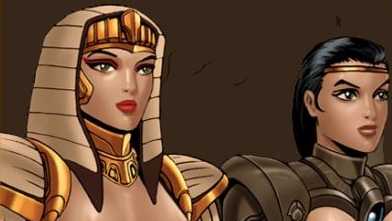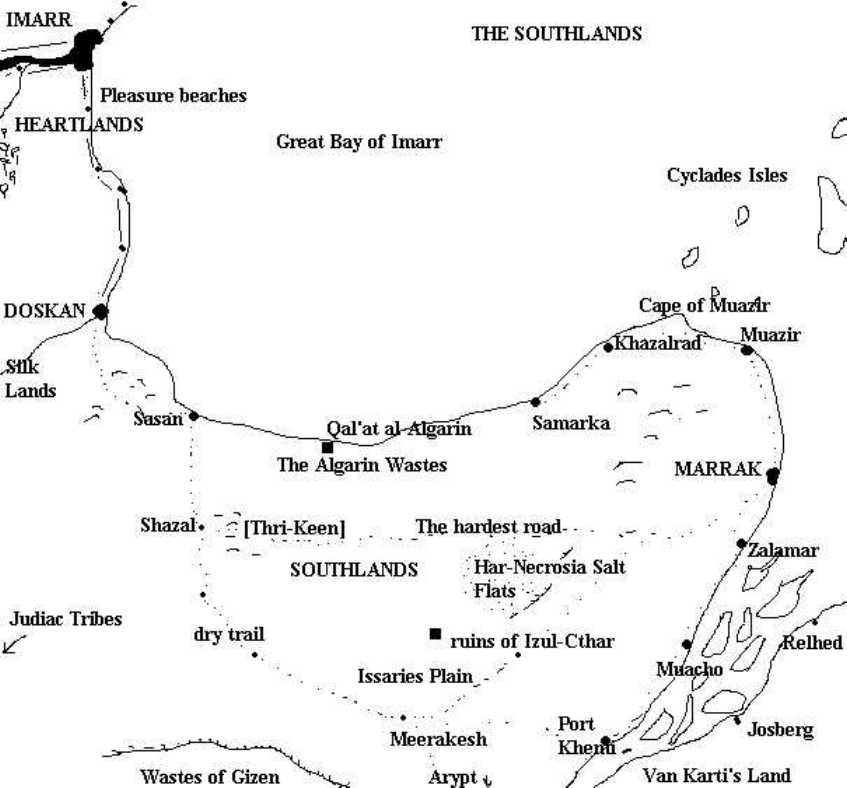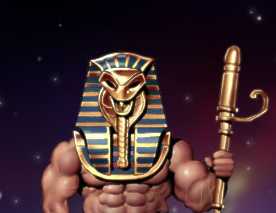
Arypt population: 0.5 million. Area: 40,000 square miles.
Ruler: Pharoah Tuthmosis IX. Capital: Tantere (pop 32,000).
The small desert realm of ancient Arypt lies south of the Marrakeen Caliphate. Once centre of a great empire, it is said to be a land of mighty magics and dreaming sands, little known to the outside world. In 2739 YE a great battle was fought at the Gorge of Osiris north of Aartuat, between the priests of Set and the allied forces of the Kheri-Heb mage-priests and Orders of Osiris, Isis and Horus. Set's minions were defeated, but the forces of light lost many great leaders, including Ramu Khem the Champion of Horus and Amitha Sefen-Re, the high priestess of Isis of the temple at Adun-Hestor. With most of the guardians of Order gone from Arypt, evil things from dark forgotten centuries are free to stir...
Languages: Aryptian, Marrakeen, Imarran Common



Translated and Annotated by Telemos Chiros �Too bad we never looted the Great Tomb! We came over from Khalla Wadi1 along the wild game and camel trails and thus entered the lands of the mud-dwellers.2 It was a good raid, for along the way we took slaves and much booty, all of which we sent back to our tribe with two hands3 of warriors as guards and to tell of our success. The shake and most of our chief warriors were for riding on toward the sunrise, but then I discovered the fort,4 and that changed everything. The enemy had built their strong place not far from where we had camped. Everyone knew that mud-dwellers stuff these forts with wealth, so all were agreed that we should attack it instead of moving onwards. �The place was too strong for us to storm, for the ones who always stay close to water5 are great cowards who hide behind walls of bricks or stones and use their magic6 in battle because they can�t fight at all. We knew that there could be only a few enemies in the fort, because otherwise the soldiers and wagon-fighters7 would have come forth to do battle when we rode in and surrounded their place. After we spent two days camped so as to surround the fort, our scouts found that the enemy had a rich burial place nearby. We abandoned the useless squatting,8 and all of us rode with eagerness into the ravine where there were many weak forts,9 mastabas,10 buildings, and tombs hewn into the rock. This sort of thing proves the mud-dwellers are crazy people, for they pay more heed to their dead than to the living. They build fine dwelling places for and squander precious things upon dried and useless corpses. This is known by all the warrior people tribes.11 �It was sad, for most of the places we found and entered had already been plundered. Mud-dwellers steal from the sacred burial places of their own. They have no shame! Besides, there are heavy curses placed upon such tombs � mostly against their own kind.12 The great ones of this land must have thought that real men would never come to where their dead bodies were placed. We showed them differently. After taking the small forts one by one, we shared out the silver and gold and other valuable stuff, too. We killed all prisoners, of course, as we now had too few warriors to guard slaves. �My cousin, Jhunna, had discovered a long, narrow path that he thought led back out of the ravine and into the mountains.13 We wanted such a trail of course, for now it was nearing the time to take our plunder and return to the clean sands of our homeland to the west. However, along the narrow way were tombs not yet touched! This was indeed work for warriors...."
Amitha Sefen-Re, High Priestess of Isis (RIP?)
Translator�s Notes 1. Khalla Wadi is the pass to the oasis of Dakhla-Amun. 2. Lands of the mud-dwellers refer to civilized, non-desert Arypt. 3. Two hands of warriors means 10 mounted tribesmen. The plunder taken must have been considerable to send off that many of their men. Incidentally, the Blemmyish, their kindred tribes, as well as most of the Yarban nomads now intermingled in the desert lands surrounding Arypt, use a quinary rather than a decimal system for counting. Numerals are used for 1 through 4, a glyph for 5, 25, 125, etc. 4. Fort is probably erroneous, as there is no mention of great wealth inside, so it is likely that the author of this tale discovered a fortified temple. 5. The ones who always stay close to water is an expression for the Aryptians in general. The nomadic tribesmen call their cavalry �soldiers,� also a derisive name, for it is not �warriors,� but nonetheless the nomads avoid confrontation, save if they can manage an ambush. 6. Magic is of course anything magical and the use of spells. The tribes are virtually helpless in this account, having no spellcasters able to match a priest or wizard, albeit they have at times managed to develop some potent sorcerers and the like. 7. Wagon-fighters is a reference to the chariots and their warrior crews still used by the Aryptians until recently, albeit on rare occasions and usually only in mass formations where the terrain is flat and hard. I suspect the barbarian is embellishing his yarn. 8. Useless squatting means the tribesmen were getting nowhere with their siege and knew it. Any fighting not done from camel or horseback is deemed improper. 9. Weak forts certainly refers to small temples or shrines, if the �fort� proper was indeed a large temple. 10. Mastabas is the Yarban word for bench, of course, and by this the tribesman means a Aryptian tomb of rectangular sort with a flat roof and inward sloping supporting walls. 11. Warrior people tribes means the Blemmyish, of course, and by inference all like nomads. 12. Curses . . . mostly against their own kind seems ignorant. Magical wards and traps will function particularly well against anyone who happens to trip them. Perhaps these tomb robbers found unguarded places or broke in through walls to avoid triggering the dweomers. 13. Mountains evidentially refers to the plateau, bluffs, hills, and ravines that form a barrier beyond the Aryptian western desert in the Middle Kingdom area. These savage nomads have probably never seen a real mountain.

That evening half the party was magically transported into the Southland desert that they had left some weeks previously, joined by four more the next morning. Leo's phantom steeds brought them 300 miles east in two days, encountering Amitha Sefen-Re, high priestess of Isis, in the deserts west of the Adun-Hestor oasis. Amitha identified Aos as Champion of Isis, and requested his help against the great evil arising in the Gorge of Osiris to the north. She identified Astragard as the Black Serpent, much to her consternation.
7/5/2739 YE
The party reached the Adun-Hestor oasis with its temple of Isis, although Astragard, Leo, Tarquin & Cho spent the night outside while the others enjoyed the delights of the temple. Astragard and Leo conversed at great length about both the ancient past and present plans.
8/5/2739 YE
Next day the group travelled north by Phantom Steeds to the village of Aartuat, where they met Khonsu-Khabeit, called the Champion of Thoth and apparently on a similar mission to Aos. Aos, Elros and Titanis helped him kill a demonic crocodile in the mill-pond. The group stayed the night at the Aartuat caravanserai.
9/5/2739
While Astragard, unwelcome in Amitha's company, stayed at the Aartuat tavern, Khonsu, Amitha and the others headed north towards the Gorge of Osiris. But only a couple of miles from the village they were ambushed by a powerful group of over twenty bandits, aided by a Sorcerer and a Priest of Set. The battle was hard fought, but the heroes triumphed and no foe escaped. On the body of the dead bandit chief was found a crimsoned metal disk - the Bloodied Moon. The Sorcerer had perished to a single arrow from Elros. He was identified by Khonsu as Shenau, an inhabitant of Aartuat. On him was found a Serpent-Ankh that radiated foulness. Xiang quickly destroyed it with White Foul Flame.
10/5/2739 YE
Waking next day in the Caravanserai's dormitory, Xiang was surprised to see the Serpent Ankh sitting on his chest, intact and unharmed. He destroyed it again, but with expectation it would return. Amitha suggested that both Bloodied Moon and Serpent Ankh could be among the Nine Evil Objects linked to the Set Rahotep, their ancient and un-mortal foe...
The heroes helped Astragard loot the Tomb of Gutheron in the Wastes of Gizen. The priestess Amitha Sefen-Re was kidnapped from Aartuat, and is believed to have been sacrificed to Set. Subsequently the heroes travelled to the Gorge of Osiris, and uncovered evidence that the dark minions of Set had gained control of the Temple of Osiris there. Elros and Cho were lost at the temple, Cho was later Raised. While the survivors returned to the Borderlands, the forces of Order were warned, a mighty force gathered under Ramu Khem the Champion of Horus attacked the Setites, and was triumphant in a titanic magical battle from which few of either side survived. Ramu Khem is said to have slain the High Priest of Set with his dying blow.
Campaign Story Hour (EN World)
Borderlands Campaign 2737-39 YE